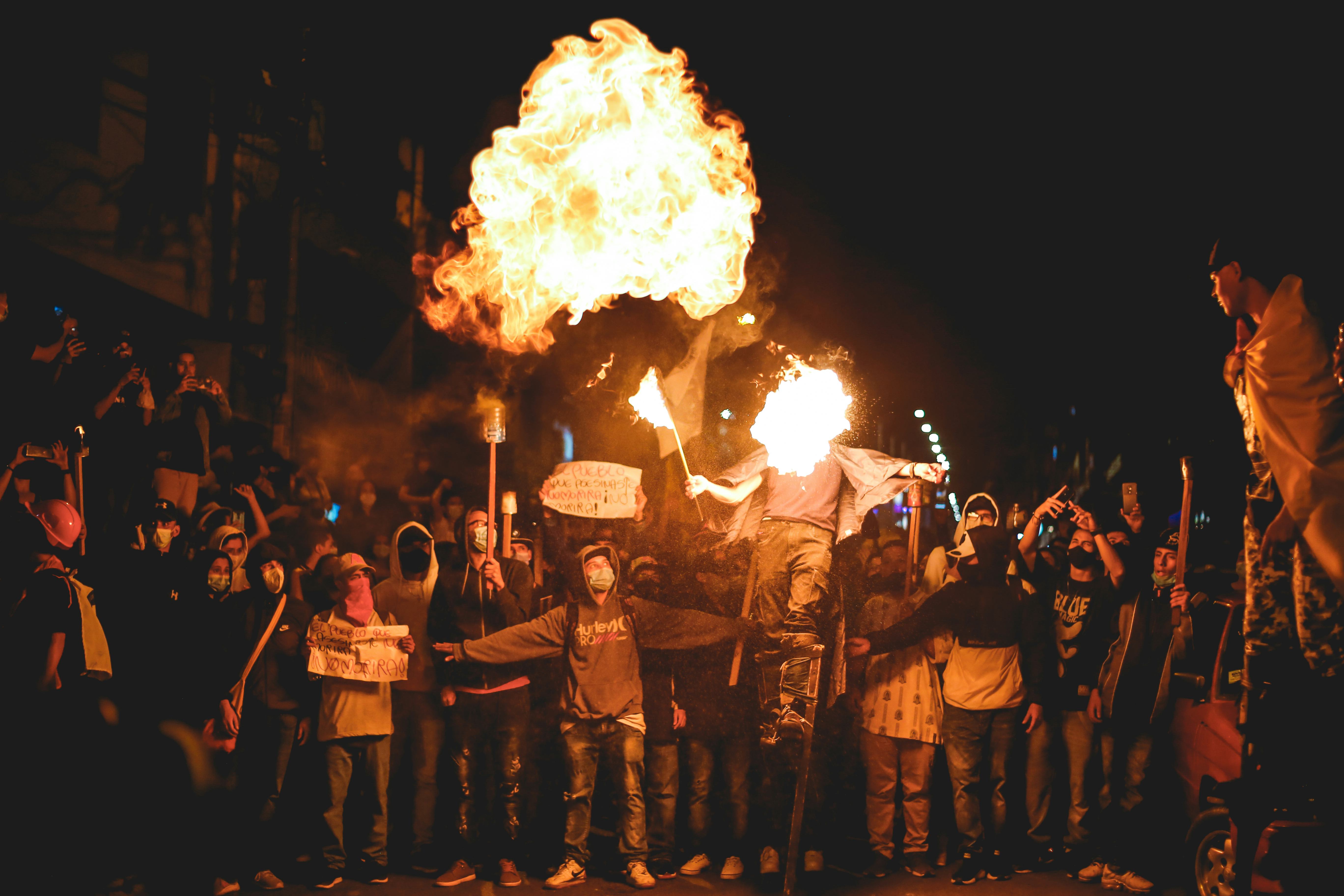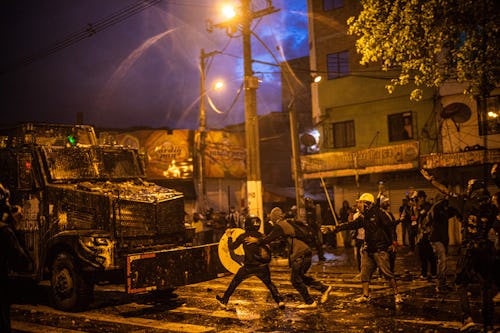
In response to a pandemic and government-induced economic downturn, Colombian President Iván Duque, who was elected in 2018, announced in late April that taxes would be raised on everyday goods in order to fund social programs. While the tax plan increased the cost of staple goods like milk and cheese, it maintained exemptions for the rich and supported a costly purchase of weapons from the U.S.
In Colombia, the gap between the ultra-rich and the very poor makes it one of the most economically stratified countries in the world. In 2019, a Gallup poll found that nearly half of all Colombians struggled to afford food and shelter, and most agreed that the gap between those who have access to wealth and those who don’t is widening.
A lack of government support throughout the pandemic, which has resulted in 3.4 million confirmed cases of COVID-19 and over 89,000 deaths, pushed hundreds of thousands of Colombians into economic precarity. If unaddressed by the government, this would allow poverty levels to worsen to a level not seen in two decades.

Protests that began on April 28 in response to the proposed tax increases that would have disproportionately burdened poor and low-income people have since morphed into large-scale demonstrations against the government writ large. “I got hope for my people; that we can see a country where our children are gonna be well educated [and] where we have [access to] a lot of resources,” Kiño, a Colombian singer and actor, tells Mic. “We are a resilient country.”
Who is protesting?
Peaceful protests have taken place in major cities like Medellín and Bogotá, as well as rural areas. Many of the protests are student-led and filled with art, music, and performance, says Kiño. “It's a lot of diverse people that are protesting. Even people that voted for Duque are protesting now,” he says, noting that people are motivated to protest because of unfulfilled campaign promises.
Kiño adds that whole cities have risen up in the wake of the proposed tax reform. “I’m from Medellín and I’ve never seen a huge movement like the protests I saw in the past weeks,” he tells Mic. “That for me was a huge moment ... if people in Medellín are protesting like that, it’s because all the country wants to change,” he says. Colombia’s previous president, Álvaro Uribe, who tapped Duque to run for office in 2018, is from Medellín, and the region has previously been sympathetic with their political party. When Medellín got in on the uprising, Kiño says, “That’s when I realized that people are getting reunited and [want] change.”
Is this just about taxes?
Four days after protests began, Duque withdrew his tax plan, heeding the protesters’ calls. The proposal would have begun taxing monthly incomes for Colombians earning just $656 per month. But even after the plan was no longer on the table, it became clear that the protests had become about the country’s existing economic and social inequities. For instance, protesters’ demands now include free public colleges and universities, police reform, and establishing basic income programs. The overall end goal is to put more power in the hands of everyday people and to have politicians who don’t respond to monied interests. “I believe that [we need to] implement a drastic and structural change [like a] redistribution of money,” Esteban Agudelo, a photographer based in Medellín, tells Mic.

For Kiño, the effort to raise taxes on the most under-resourced Colombians is a continuation of Duque’s record of broken promises. “When [Duque] was running for office, he was saying the opposite: ‘I’m not gonna raise taxes. I'm gonna improve health for poor people,’ and that’s a lie too,” Kiño says.
How are protesters pushing back against the government?
Both Kiño and Agudelo say that there’s a difference between the protests during the day and those in the evening. During the day, protests are generally peaceful, but at night the energy changes, Agudelo says. “There’s definitely protesters that are in the night that you can identify as being more aggressive in their approach,” Agudelo tells Mic. He says that police in turn respond by being more aggressive with their crackdown efforts.
Protesters have blocked major roadways, preventing travel as well as commercial traffic and stalling access to food and gasoline in some parts of the country. However, the Duque government has used the roadblocks as an opportunity to shift blame for the country’s issues onto the people, rather than seeing the protest as a response to government-induced insecurity. When 1.5 million Colombians can’t afford three meals a day, Agudelo says, the problem of food insecurity isn’t just about the past month; it’s about the past 60 years of ineffective government.
Kiño adds that the government is in fact using the blockades to increase its military presence. Recently, Duque ordered the “increase of all operational capacity of our public security forces on the ground to — together with mayors and governors — unblock the roads of our country with strict adherence to human rights."

Combined, the pandemic and the protests have changed the landscape of everyday life for Colombians living in some cities. As one BBC report talking about the city of Cali, which is Colombia’s third largest, said: “Cali, in any case, is paralysed. Everyday life has been affected by the blockades and petrol shortages: If you need a plumber or someone to fix your internet connection, you are going to have to wait for days, or even weeks. Most shops are shuttered and their doors have been sprayed with anti-government graffiti.”
What is the police response?
Duque has resolved to tamp down on protests with force. According to Human Rights Watch, police have killed at least 20 protesters, with the organization estimating the overall death toll from the demonstrations at 68. And while some police departments have opened investigations into police misconduct, Kiño says that the shadow violence against protesters is much more insidious: Hundreds of people have “disappeared” across the country, he says, and their bodies are found later, after they’re reported missing.
The situation out in the open is violent, too. “The main thing that you see is excessive force,” Agudelo tells Mic. “If someone throws a rock, that doesn't justify them getting shot.” Agudelo says that police don’t use guns during the day to disperse protests, instead deploying “non-lethal” weapons like tear gas in ways that can cause lifelong debilitating harm to protesters. “Police are being abusive in that position of power,” Agudelo says. He’s seen police aim their “non-lethal” weapons directly at protesters’ faces; The Guardian reported that police have caused eye injuries in at least 46 protesters.

Agudelo claims that government forces are also censoring what information is available via social media. For instance, he says, Facebook Live, which people were using to stream marches and protests, was taken down, and some of his photographs of the protests were removed from Instagram without explanation. Agudelo also says that there have been “whole cities where the internet was disabled,” like in Cali, and that the government reported the outages as unintentional damage though protesters think it was very much intentional.
What does a resolution look like?
In May, government officials and members of the Duque administration met with activists who organized the protests, the National Strike Committee, student organizers and union leaders. However, it appeared that the administration was not willing to meet protesters’ demands, and instead chose to escalate the government presence by sending in national troops.
To Kiño, the struggle in Colombia is simple: It’s a fight for human rights against a government that doesn’t want its people to access them. Why else would the desire for a basic income, access to health care, and affordable housing incite discord between Duque and the people of Colombia? In other words, Kiño says: “Why [won’t] they let human rights come to the country?”







